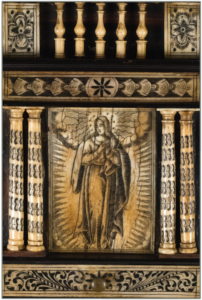Cabinet on Stand
White Oak with Ivory and Ebony
Italian, 17th or 18th century
Donated to the Museum & Gallery in 1973, this beautiful antique was described merely as a “Chest of Drawers,” believed to be Dutch, from the late 16th century. During the cabinet’s history in the collection, the mirrored base on which it was first displayed was swapped out for the more suitable, baluster-turned legs on which it currently stands (though not original).
 The Cabinet is substantial, standing five-and-a-half feet tall (including the base), almost four feet wide, and 15 inches deep. Beyond that, not much has been known about the Cabinet beyond its style (Baroque) and composition (finely detailed ebony and inlaid ivory veneers on the face of oak drawers and doors). Three etched ivory plaques, possibly based on engravings, grace the front of the piece. These picture the Apostle John on the left lower door and John the Baptist on the right. Both doors are lockable with the original key. The central, etched ivory plaque depicts Mary, the mother of Christ, framed by three-dimensional carved ivory columns to either side.
The Cabinet is substantial, standing five-and-a-half feet tall (including the base), almost four feet wide, and 15 inches deep. Beyond that, not much has been known about the Cabinet beyond its style (Baroque) and composition (finely detailed ebony and inlaid ivory veneers on the face of oak drawers and doors). Three etched ivory plaques, possibly based on engravings, grace the front of the piece. These picture the Apostle John on the left lower door and John the Baptist on the right. Both doors are lockable with the original key. The central, etched ivory plaque depicts Mary, the mother of Christ, framed by three-dimensional carved ivory columns to either side.
While those details of the Cabinet are basic, they communicate a significant amount about the furniture’s place and date of origin, as well as the type of owner it was likely built for. First, however, it’s helpful to know some of the history of cabinets as furniture.
Cabinets utilizing ebony wood date back at least to Egyptian times, like several discovered in Tutankhamun’s tomb in 1922. Such dedicated, highly decorated storage furniture demonstrated the status and wealth of its owner. Over intervening centuries of adaptation, storage and collection cabinets proliferated in both Eastern and Western cultures, though only the wealthy could afford the most finely constructed and exotically decorated pieces.
Ebony wood was a favorite material, sourced only from ebony tree varieties in western Africa, India, and Indonesia. Because ebony was scarce, craftsmen learned to shave and apply thin veneers of the jet-black ebony heartwood on top of readily-available wood species used for the rest of the object. The dark background was then inlaid with contrasting materials such as ivory, metal, lighter woods or semiprecious stone.
As early as 1566, the inventory of a room in the Ducal Palace of Mantua (in northern Italy) lists an ebony cabinet with inlaid ivory panels. Though the Ducal version was likely made 150-plus years prior to M&G’s Cabinet (dating sometime in the late-17th or early 18th century), both share similar intricate ivory inlay and metal filigree.
Piecing together that general history helps in suggesting the origins and ownership of M&G’s Cabinet on Stand The condition of the ivory and construction methods distance the cabinet from the 19th-century revival of ebony and ivory furnishings.
However, the ivory demonstrates some discoloration and shrinkage from age, while the cabinet frame, back, and drawer construction seem more consistent with an earlier date. The white oak used as the secondary wood was common only in northern Italy (Venice or Milan, but not Rome) and Northern Europe (German, Holland, and Flanders).
The etched biblical figures expressed in the inlaid ivory seem more “lively” and less restrained than is common when artists in Protestant countries present the same figures. That suggests a Roman Catholic country of origin, such as Italy.
Finally, the totality of the Cabinet—exotic materials, time-consuming craftsmanship, and subject matter—indicate a prominent and wealthy patron. The religious subject matter likely indicates that the original owner was a highly-placed churchman, perhaps a bishop, using the cabinet as a way to flaunt both his religious devotion and his prominence/wealth.
Good examples of similarly inlaid antique chests exist. Some of the best examples can be found in the collections of the Victoria & Albert Museum (dating from about 1600), the Museum fur Kunst & Gewerbe (Hamburg, Germany), and some auction sites such as Sotheby’s and Christie’s, as well as high-end antique dealers.
Dr. Stephen Jones, M&G volunteer
Resources
David L’Eglise, partner at Village Antiques at Biltmore
Published 2022
